So you’ve decided to embark on your resistance band journey. Awesome! But you don’t want to waste money on getting more bands than you need. Nor do you want to limit yourself by having access to too few bands. So how many resistance bands do you actually need? That’s what I’ll be answering today.
It is recommended to get 3-5 individual resistance bands to train effectively. Each band should provide a different weight; including light, medium, and heavy. This allows most people to achieve a variety of goals including muscle-building, fat loss, and cardio improvement.
In my 5+ years of experience with resistance bands, I’ve trained with a single band as well as used a complete set.
And let me tell you the difference is night and day.
Below, I’ll explain why I found it so much better to get more than one resistance band!
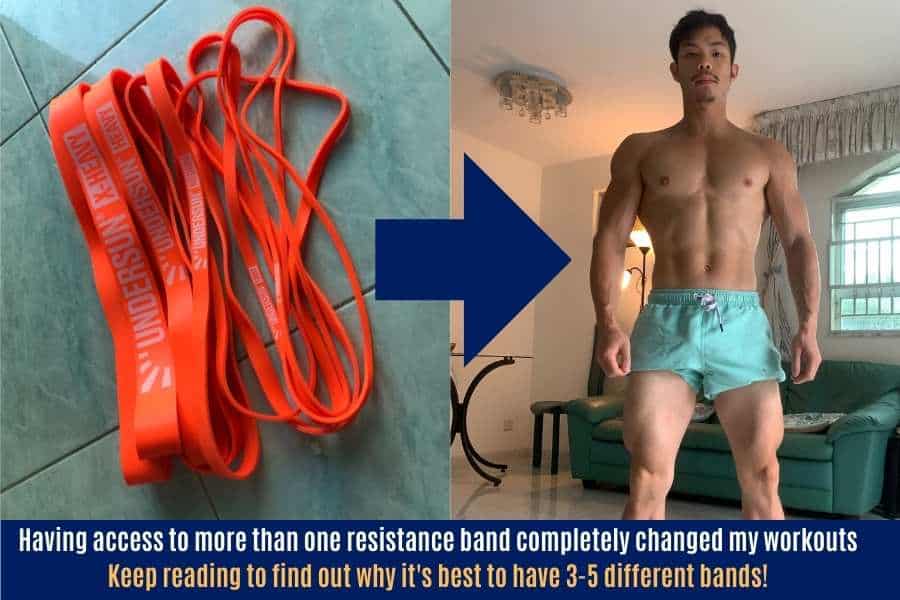
- Recommended Resistance Band Set
- The Number Of Resistance Bands You Need Depends On Your Goals
- How Goals Determine The Number Of Resistance Bands Needed
- Why It's Good To Have More Than One Resistance Band
- Other Reasons Why It's Good To Have More Than One Band
- How To Use More Than One Resistance Band In A Set
- Combining Resistance Bands To Increase Weight
- When Multiple Sets Of Resistance Bands Can Be Beneficial
- Why I Prefer The Undersun Set Over Buying Single Bands
- Conclusion
Recommended Resistance Band Set
I demonstrate various principles throughout this post using the Undersun resistance bands.
These are the bands I currently use and recommend.
They are affordable and provide enough individual bands and total resistance for most people to reach all training goals.
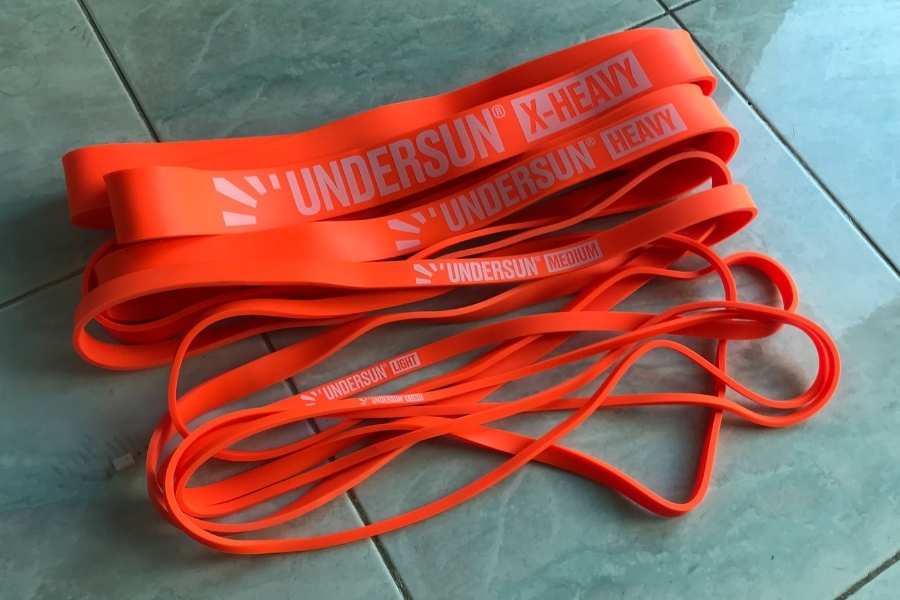
If you’re looking to build muscle, increase strength, tone up, or just lose some weight; this set will help you to achieve your goals.
The Number Of Resistance Bands You Need Depends On Your Goals
When asking the question of how many resistance bands you need; the short answer is that 3-5 bands are optimal.
Assuming that’s 3 to 5 bands each providing a different resistance, this gives you a versatile amount of weight to accomplish most goals.
Whether you’re looking to use your resistance bands to build strength and muscle, lose belly fat, improve cardio, or just for general fitness; 3 to 5 different band weights will generally be enough.
The longer answer to the question is however much total resistance you need to accomplish your goals as follows:
| Training Goal | Total Resistance Required By A Beginner (approx.) | Minimum Number Of Resistance Bands Recommended |
|---|---|---|
| Build muscle and strength. | 100-200lbs | 3 to 5 |
| Improve cardio and burn fat | 50-100lbs | 2 to 3 |
| General fitness | 10-50lbs | 1 to 2 |
Next, I’ll explain why your training goals affect the amount of weight, and therefore the number of bands, that you are recommended to get.
How Goals Determine The Number Of Resistance Bands Needed
- Building muscle and strength. This requires heavy lifting and progressive overload (increasing weight over time). Having access to multiple bands, each with different resistances, allows you to effectively train all muscle groups (large and small). Having multiple resistance bands also gives you the flexibility to combine them to make heavier weights. 3 to 5 bands from light to heavy are generally enough for most people to build muscle.
- Improving cardio and burning fat. This usually involves performing as many reps as possible using a light weight in the shortest time frame possible. The overall goal is to maintain an elevated heart rate. Therefore you don’t really need that many resistance bands. One light and one medium band are sufficient for most people. But getting a third band (I recommend a heavy one) can provide an option for you to progress if and when you outgrow the other two bands.
- Maintaining general fitness. This requires the least number of resistance bands. The goal here (for most people) is to do just enough work with your resistance bands to reap health benefits. As a beginner, having access to 1 or 2 light bands is sufficient to achieve this.
You can check out my other post to learn how much weight heavy, medium, and light bands should provide!
Why It’s Good To Have More Than One Resistance Band
Having more than one resistance band is recommended not unessential. Owning multiple resistance bands with different weights allows different muscle groups to be trained effectively. Additionally, multiple bands provide superior versatility and offer the best flexibility for progression.
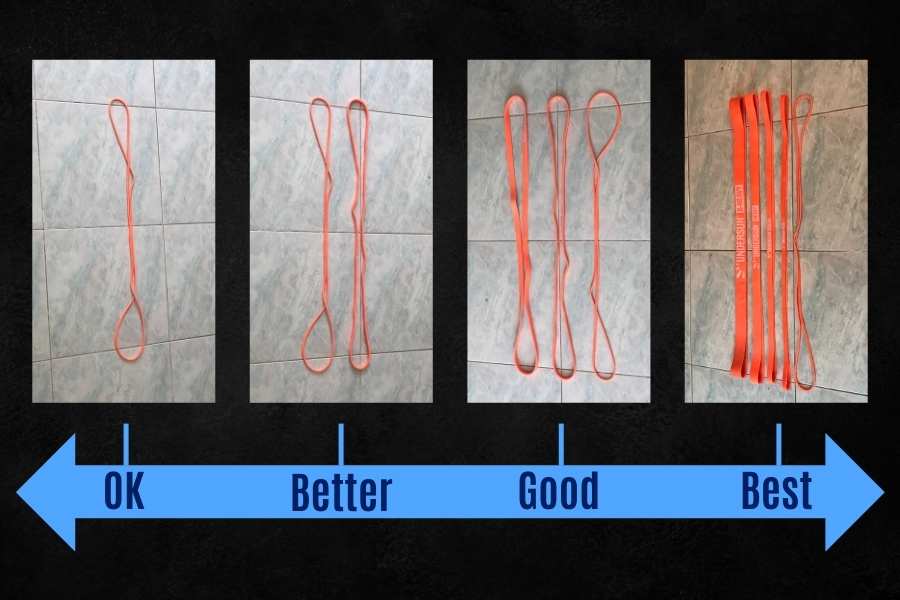
One important thing to remember is that resistance bands are not created equal.
Different bands serve different purposes.
For example, let’s compare an extra heavy band that gives 120lbs of resistance with an extra light band that only gives 10lbs of resistance:
| Resistance Band Weight | Recommended Training Level | Ideal Purpose |
|---|---|---|
| 10lbs | Beginners | Light isolation-type movements like bicep curls, cardio, fat-burning. |
| 120lbs | Intermediate-advanced | Heavy compound-type movements like chest presses to build muscle and strength. |
The difference between these bands is night and day.
The former is more suited to performing light isolation-type band movements like bicep curls and glute bridges that work smaller muscle groups (often single muscles).
These movements are good for defining specific muscles like the biceps and glutes. They are popular with beginners. These bands are also great for cardio, fat-burning, and general fitness workouts.
In contrast, the latter is ideally suited to performing heavy compound resistance band movements like presses, rows, squats, and deadlifts that train large muscle groups.
These movements are great for building muscle and strength across the whole body. They are popular with intermediate-advanced lifters trying to bulk up and get bigger.

Therefore it’s always a good idea, where possible, to have multiple resistance bands.
Each band should offer a different weight such that you don’t pigeonhole yourself to a particular movement or style of training.
The aim is to have access to a spectrum of weights readily available.
And this allows you to effectively train small and large muscle groups alike!
Other Reasons Why It’s Good To Have More Than One Band
Being able to effectively target different muscle groups is the main reason why it’s good to have more than one resistance band.
But there are also two other reasons why it’s a good idea to buy multiple bands:
- Goals can change over time. You may be starting your band training journey with general fitness in mind. But before you know it, your goals may switch to building muscle. This is not uncommon as beginners develop a new-found enthusiasm for their resistance band workouts. Having more than one resistance band gives you the versatility to do so.
- Fitness increases over time. This will happen naturally if you’re following an effective program. If you don’t keep yourself challenged by increasing resistance, you’ll likely find yourself stagnating in no time. In other words, your fitness no longer increases beyond your current level. Having more than one resistance band gives you the option to increase your workout intensity and further improve your fitness!
If you’re new to band training, you may be interested in my other post for 15 of the best resistance band movements for beginners!
How To Use More Than One Resistance Band In A Set
OK great so you have a resistance band set with multiple bands at different weights.
Now you need to know how to use them properly.
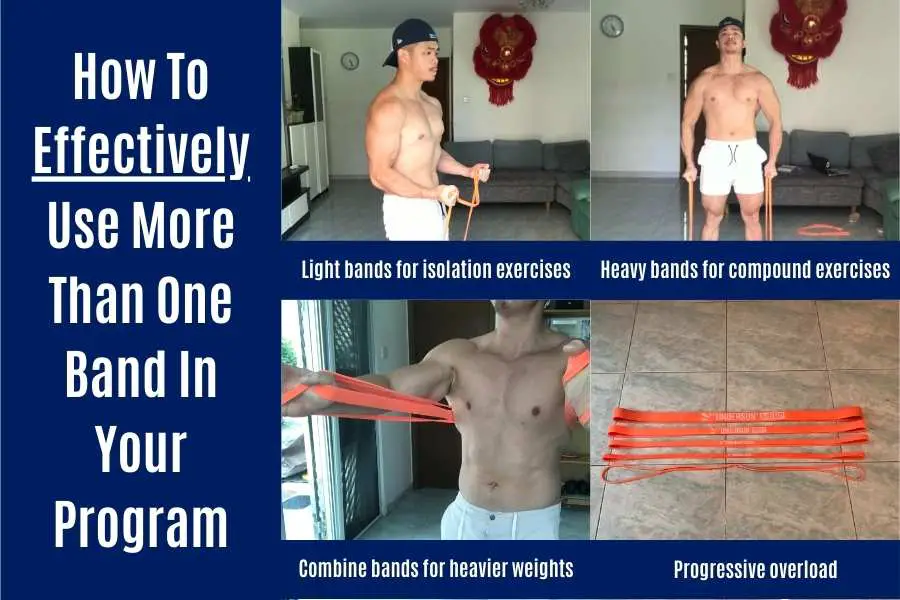
Here’s how to take advantage of having more than one resistance band in your arsenal:
- Use the heavy bands for large muscle groups. I’m talking mainly about the back, chest, shoulders, and legs here. The best movements for building muscle in these areas are rows, chest presses, overhead presses, and squats/deadlifts (respectively). Heavy bands are ideal for these exercises which generally involve multiple muscle groups.
- Use the light bands for small muscle groups. I’m talking about specific muscles like the biceps, triceps, deltoids, glutes, and abs here. The best movements increasing tone and definition in these muscles are curls, tricep extensions, lateral raises, and crunches (respectively). Light bands are ideal for these exercises which target single muscles.
- Progressive overload regularly. You should move on to the next heaviest band whenever a particular exercise is no longer challenging. For example, if you’re doing 8 reps of bicep curls and find the last few reps to be easy, then you know to increase the weight. The more resistance bands you have, and the smaller the weight increments, the easier it is to progress.
- Combine multiple bands to increase weight. If you’ve been working on your resistance bands for a long time, you may find that you outgrow the individual bands. At this point, you should combine multiple bands to form a new weight (see next).
Combining Resistance Bands To Increase Weight
Combining multiple resistance bands is an effective way to increase weight. Beginners should start by using 2 resistance bands instead of 1. For best results, the combined resistance for both bands should be approximately 10-20lbs heavier than the individual bands.
Here’s why it can be beneficial to combine 2 resistance bands to increase weight:
- Strength progression. Most people will eventually outgrow the resistance of individual bands (especially if you’re taking your workouts seriously and overloading regularly). At this point, the most cost-effective way to further increase weight and continue making strength gains is to double up and combine individual resistance bands.
- Increased band durability. Resistance bands are durable but they can snap and break very quickly if they aren’t used properly. A common mistake that decreases a band’s lifespan is to double-loop. This is where you fold the band in half to double the resistance. Although this method works, it usually overstretched the band past its safe limit. This can cause tears to form which eventually lead to the band completely snapping. It’s much better to just combine two individual bands to make a heavier weight.

When you combine 2 resistance bands, it’s important to not overdo it.
Lifting more weight than you can handle is not only dangerous but also promotes bad form (which decreases exercise effectiveness).
Remember- the combined resistance is the sum of both bands.
So if you’re combining a 120lb band with an 80lb band, then the total is 200lbs. This 80lb jump is more than what most people can manage.
Instead, combine the 10lb band with a 20lb band for a more manageable weight!
If you’re unsure what is meant by a “120lb band” etc, you can check out my other post for a full explanation of the meaning of resistance band weight.
When Multiple Sets Of Resistance Bands Can Be Beneficial
Most people will find that one set of resistance bands is enough. However, having access to 2 sets of bands can serve as a spare for those who regularly push their bands to their physical boundaries. Most people do not need more than 2 sets of bands.
Aside from the second set serving as a spare, here are some other scenarios where having 2 sets of resistance bands can be useful:
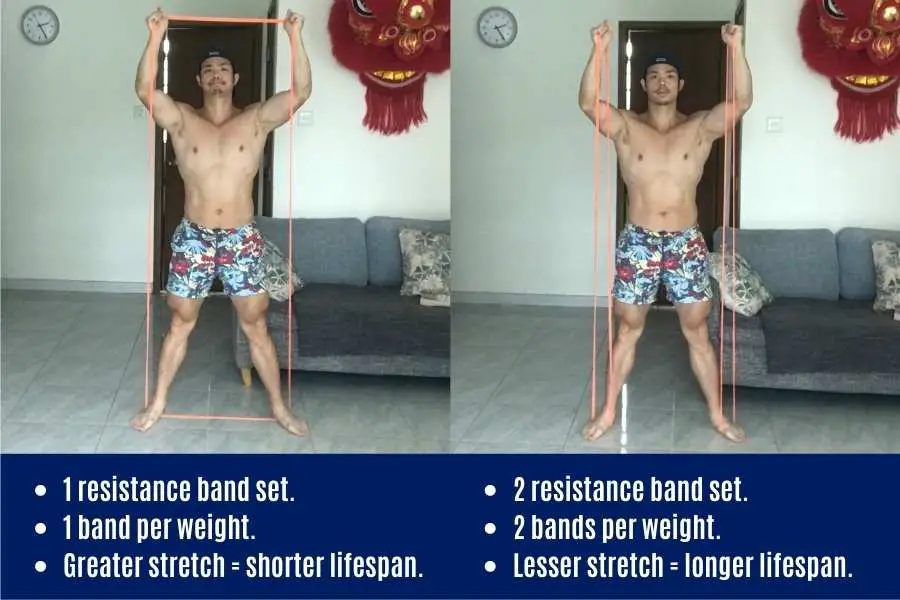
- People who perform unilateral exercises. Almost all resistance band sets come with a single band at each weight classification (e.g. 1x light, 1x medium, and so on). But sometimes you want 2 versions of the same band to perform unilateral (one-sided) movements like a shoulder press. Here, having two sets of resistance bands can be helpful.
- Those who want their bands to last longer. Referring back to the above shoulder press example again, your bands will last longer if you use two identical bands as opposed to a single band. That’s because using two bands means less stretch is being applied for the same amount of tension.
- Those who want to micro load in their band progression. Some people prefer getting 2 sets of resistance bands to give them more flexibility in how they overload. Having 2 sets of bands allows you to combine 2x 20lb bands for micro loading rather than being forced to combine a 20lb band with a 50lb band, for example.
Why I Prefer The Undersun Set Over Buying Single Bands
First things first- I could be recommending any other brand of resistance band.
But I don’t.
I recommend the Undersun Fitness bands.
Why?
Having cycled through half a dozen brands in my 5 years using them, I found the Undersun bands to provide the best value for money.
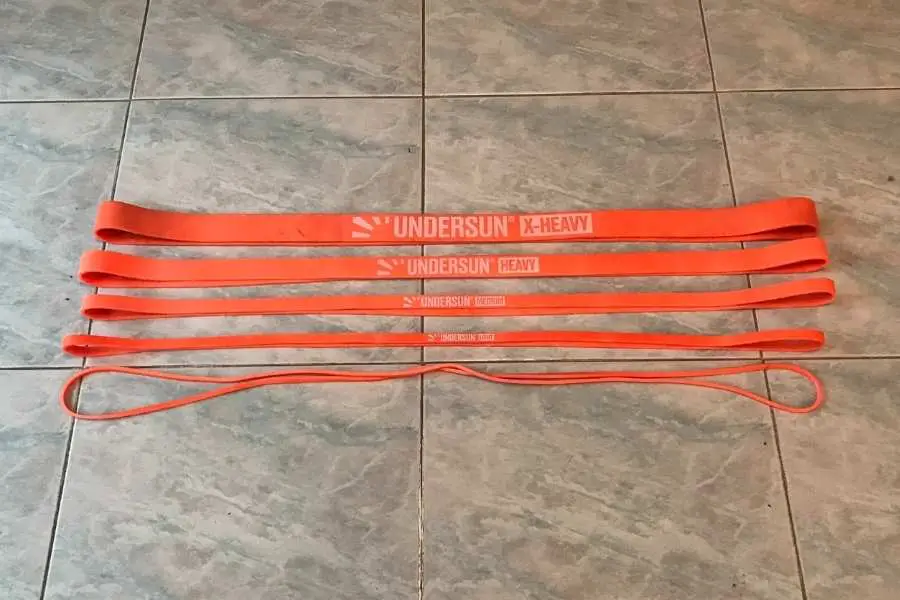
The set itself doesn’t cost any more than purchasing single bands individually. And they aren’t much more expensive than the budget tube-style bands with handles (which snap very easily by the way).
The Undersuns come in a set of 5 bands ranging from extra light to extra heavy.
It works equally well for defining small muscles as well as building larger muscle groups. This set will also provide enough resistance to take you from beginner to intermediate-advanced stages of band training!
Conclusion
I’ve explained how many resistance bands you need.
Whilst a single resistance band can be sufficient to get a workout, most people will find that having access to multiple bands as part of a set will take your workouts to a completely different level.
The exact number of bands recommended will vary depending on your exact goal.
But generally speaking, 3-5 bands are optimal.
I’ve also explained why getting multiple resistance bands can help you reach your fitness goals more quickly than if you were to only have access to one band.
That’s because using multiple bands will allow you to overload your muscles more efficiently.
Additionally, combining multiple bands to form heavier weights can help them to last longer versus a single band that’s been double-looped upon itself.
How many resistance bands will you be getting?
Feel free to send me a message if you have any questions! You can find my details on the “contact us” page.
You may also be interested in the downloadable Kalibre Blueprint PDF which details exactly how I gained 40lbs of lean muscle (it’s 100% free!). It details the exact exercises and nutrition (with printable worksheets) I used to go from skinny to ripped!
Thanks for reading guys!
Peace Out,
Kal
(Biochemistry BSc, Biomedical Sciences MSc, Ex-Skinny Guy)


